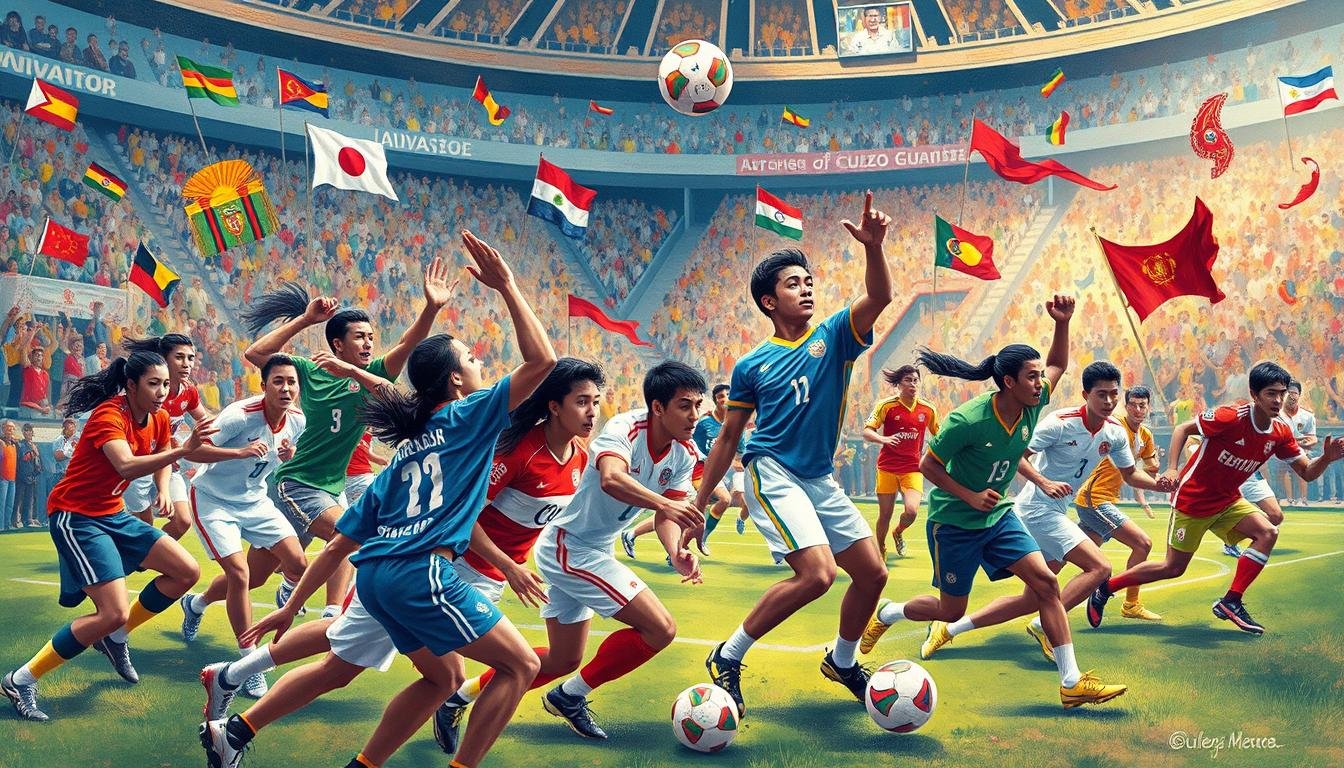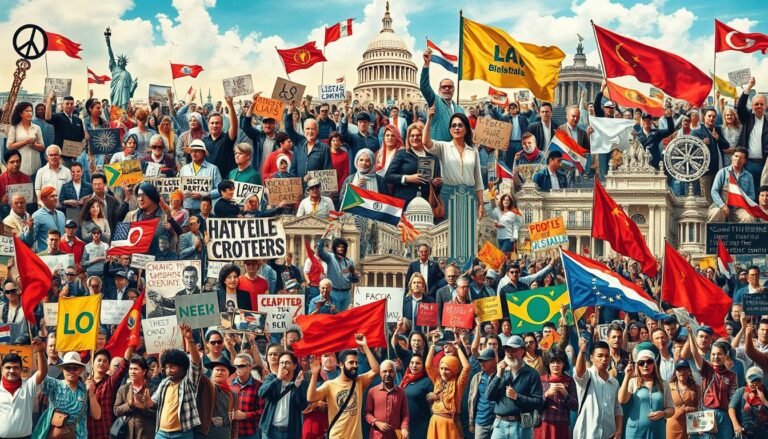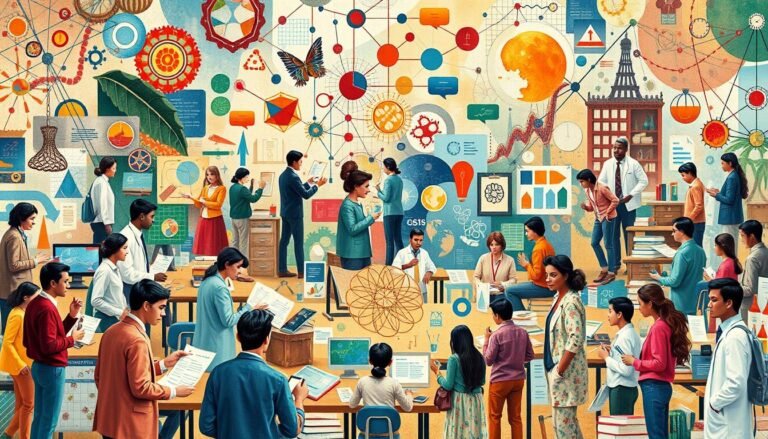The Sociology of Sports: Identity and Society
Ever thought about how sports shape our identities and our place in society? The study of sports sociology looks into this interesting link. It shows how our favorite games and athletes affect our identities and social groups.
Sports culture is key in shaping our individual and group identities. It goes beyond the game, affecting our lives and communities deeply.
Being an athlete is more than just being good at sports. It’s about blending personal values, social norms, and cultural beliefs. When we support our teams and admire athletes, we’re part of a bigger story. This story shapes our identity and what we believe in.
Key Takeaways
- Sports sociology looks at how sports and society are connected.
- Athletic identities come from how others see and support us.
- Sports are important in teaching us social skills from a young age to adulthood.
- Gender, race, and national identity are shaped by sports.
- Sports sociology has grown since it started in 1966.
- Starting with sports early predicts we’ll keep being involved in them.
- Sports influence our feelings and moral views.
Introduction to the Sociology of Sports
Sports sociology looks at how sports and society are connected. It shows how sports shape our identities and social groups. This area mixes the thrill of sports with deep insights into society.
Definition and Scope of Sports Sociology
Sports sociology looks at how sports reflect and shape social norms. It covers everything from kids playing to pro leagues. It explores how sports help form our identities and shape how we interact with others, across ages and cultures.
Historical Development of the Field
The 1960s marked the start of sports sociology as a unique field. Researchers came together, creating groups and journals. Since then, the field has grown a lot. The second edition of “The Sociology of Sports: An Introduction” in 2015 shows how it has evolved, with new trends and stats.
Key Areas of Study in Sports Sociology
Sports sociology looks at many parts of sports and their social effects. Some main areas include:
- Youth sports participation and development
- Gender dynamics in athletics
- Race and ethnicity in sports
- Economic factors in professional sports
- Media representation of athletes
- Sports and national identity
These topics help us see how sports mirror bigger social issues. For instance, sports are a key part of life worldwide, playing a big role in how we connect with others and build communities.
“Sport is considered as important as major social institutions such as family, religion, politics, economics, and education in American society.”
This field keeps growing, tackling new issues like social media’s effect on athletes and the rise of esports. By looking at sports sociologically, we learn a lot about our society’s values, challenges, and how we can change for the better.
The Role of Sports in Identity Formation
Sports are key in shaping who we are and where we belong. By joining sports, people find their identity and a place to fit in. Studies highlight how sports sociology is important, focusing on culture, media, and gender.
Athletes often see themselves as part of their sport. This happens through interactions with teammates, coaches, and rivals. Research found that culture, media, and gender are top topics in sports sociology.
Sports shape our identities not just on the field. Fans and communities also find their social identities with their favorite teams or athletes. This shared identity brings a sense of belonging and helps in personal growth.
- Athletic identity measurement scales have been developed and validated
- Research explores identity changes post-injury and during retirement
- Studies examine the relationship between athleticism and moral functioning
Sports impact identity formation at all levels, from youth leagues to pros. People shape their self-image through sports. Even after stopping, former athletes keep parts of their sports identity.
“Sports provide a unique platform for personal growth and social connection, allowing individuals to forge identities that transcend the boundaries of the game.”
Socialization Through Sports: From Childhood to Adulthood
Sports are key in helping kids grow and shape their lives. They start learning social skills early on. This shapes how they see their place in the world.
The Play Stage and Game Stage
Young kids start with free play, then move to organized sports. This change teaches them about rules and teamwork. It helps them understand who they are and their roles in society.
Gender Differences in Sports Participation
Gender roles in sports show up early. Boys have often been pushed more to join competitive sports. This has made kids see their athletic potential differently.
| Decade | Boys’ Participation | Girls’ Participation |
|---|---|---|
| 1950s | High growth | Limited growth |
| 1970s | Continued growth | Increasing |
| 2000s | Stable high levels | Significant growth |
Influence of Family, Peers, and Media
Family, friends, and media affect how we see sports. Parents introduce kids to sports, and friends keep them interested. Seeing athletes on TV can also make kids want to try sports.
Studies show that being involved in sports boosts self-esteem and self-control. As people get older, their sports experiences keep shaping who they are. Sports are a key way to grow personally and socially.
The Sociology of Sports: Identity and Society
Sports are key in shaping our society and our identities. They go beyond the game, affecting how we see ourselves and others. Since the North American Society for the Sociology of Sport started in 1978, we’ve deeply studied this link.
The Sociology of Sport Journal has led in showing how sports mirror and question social norms since 1984. It looks at how women’s roles in sports have changed. In the 1800s, women were not allowed to play sports. It wasn’t until 1850 that colleges started teaching physical education to women.
Today, women’s sports still face gender disparities. They get less media coverage than men’s sports. This imbalance shapes how society sees athletes and influences our identities. Title IX in 1972 was a big step towards gender equality in sports, making sure no one was left out because of their sex.
| Year | Event |
|---|---|
| 1966 | Roberta Gibb finishes Boston Marathon in 3:21:25 |
| 1972 | Title IX passed |
| 1977 | Renée Richards wins right to compete in U.S. Open |
| 1980s | Women allowed to run marathon in Olympics |
Sports and society keep evolving together, shaping our identity and challenging beliefs about gender, race, and ability. As we move forward, studying sports sociology is key to understanding these complex interactions.
Sports and National Identity
Sports are key in shaping a nation’s identity and bringing people together. They help build a sense of unity and culture on the world stage. In new countries, sports play a big role in creating a shared identity.
The Role of Sports in Nation-Building
Sports are vital for building a nation. They offer a common experience that goes beyond social differences. In Slovenia, for example, sports helped create a new national identity after it became independent in 1990.
Sports as a Tool for Cultural Diplomacy
International sports events are great for cultural exchange and showing off a nation’s values. Athletes act as ambassadors, sharing their country’s culture with the world. This kind of sports diplomacy helps nations connect and understand each other better.
Case Studies of National Sports and Identity
Various sports have special meanings in different countries, helping shape their identity:
- Cricket in the West Indies
- Baseball in Cuba
- Football in many Latin American countries
These sports often bring people together, crossing class and ethnic lines. They create a shared passion among diverse groups.
| Country | National Sport | Impact on Identity |
|---|---|---|
| West Indies | Cricket | Unifies Caribbean nations |
| Cuba | Baseball | Symbol of national pride |
| Brazil | Football | Integral to cultural identity |
Studies show that sports can help build and keep a nation’s identity, especially in countries moving past socialism or colonial rule. The link between sports and national identity is always changing, influencing the culture of countries around the world.
Race and Ethnicity in Sports
Sports have always reflected the racial issues of society. In the 19th century, racial science grew alongside sports like rugby and cricket. These sports were seen as ways to “civilize” colonized people, supporting the idea of white European superiority.
The 1960s brought progress against racial discrimination in sports. Athletes like Jack Johnson, Jesse Owens, and Jackie Robinson made big changes. In cricket, Frank Worrell became the first black captain of the West Indies team, showing progress towards equality.
Media often talks about athletes in ethnic terms. Athletes of color are seen as naturally talented but not hardworking. On the other hand, white athletes are praised for their hard work and leadership. This shows the deep racial issues in sports.
Sports bring together athletes from different ethnic backgrounds. Immigrants play sports from their home countries, keeping cultural ties alive. Japanese Americans used sports to cope during World War II internment camps.
“Sport is a powerful tool for social change, but it can also reinforce existing inequalities.”
Racism in sports happens at many levels. Racist chants and violence still happen at some games. Critical race theorists believe racism is easily spread in sports and society.
| Racial Issue | Impact on Sports |
|---|---|
| Stereotyping | Affects player positioning and media representation |
| Institutional racism | Embeds discriminatory practices in sports organizations |
| Structural racism | Limits access to sports and athletic development opportunities |
Gender Dynamics in Sports
Gender equality in sports has made progress, but there are still hurdles. Since the 1970s, research has shown a gap in sports participation between men and women. Men are more likely to join sports than women. This gap also exists in leadership roles, with men leading in coaching and administration.
Women’s Participation in Sports: Challenges and Progress
Legislative efforts like Title IX in the US have helped reduce barriers for female athletes. This has led to more women and girls joining sports. But, there are still obstacles. Early research pointed out gender inequities but didn’t fully address how sports systems favor men.
Media Representation of Female Athletes
Female athletes often get less coverage in sports media. The focus is more on how they look than their athletic skills. This kind of coverage helps keep gender stereotypes alive and doesn’t give women’s sports the respect they deserve.
Gender Equality Initiatives in Sports
There are ongoing efforts to make sports more equal for everyone. These efforts aim to improve participation, leadership, and how women are represented. But, there are new debates about including transgender athletes in school sports.
| Year | Opposition to Trans Athletes |
|---|---|
| 2021 | 62% |
| 2023 | 69% |
The table shows more people are against letting transgender athletes play on teams that match their gender identity. This shows the tough challenges in reaching true gender equality in sports.
The Impact of Sports on Social Structure and Mobility
Sports are key in shaping our social structure and helping people move up in life. In China, marathons are getting more popular. Now, 7.12 million people run them, up from 2.8 million in 2016.
People living in cities want to join sports more than those in rural areas. This shows how city life changes people’s values and what they like to do. For many, running is a way to take control of their lives.
Running together has become a big thing in China. It makes people healthier and happier, and helps them make friends. Sports like this create new groups and networks, changing social structures.
The sports industry is a big deal economically. In 1998, people spent $17.7 billion on sports, and another $21.4 billion on fitness clubs. This shows how sports affect our society.
“Sport is not always a direct avenue to upward social mobility.”
While sports can help people move up, it’s not always easy. Some think it’s a myth that sports can quickly improve your social status. But, research shows that being in college sports can really help your social standing.
| Aspect | Impact on Social Structure | Impact on Social Mobility |
|---|---|---|
| Marathon Participation | Creates new social communities | Provides networking opportunities |
| Group Running | Builds support networks | Improves mental health and confidence |
| Collegiate Athletics | Reinforces meritocratic values | Shows positive effects on upward mobility |
Conclusion
The study of sports and society, known as the sociology of sports, has become very important since the mid-20th century. It helps us understand how sports and society are connected. The International Sociology of Sport Association, started in 1964, has played a big role in this field.
Sports sociology shows how sports can bring people together and help them feel connected to their culture. For example, the West Indies cricket team was a symbol of unity for people from Afro-Caribbean backgrounds after they gained independence. In Canada, cricket also keeps the cultural ties strong among Afro-Caribbean immigrants.
Looking to the future, sports sociology will likely explore how the world is becoming more connected. We’ll study how big events like the Olympics and big companies affect sports all over the world. As sports change, understanding their impact on society will be more important than ever.
This field brings together experts from many social sciences to study sports and society. This mix of perspectives helps us tackle the big challenges and chances that come with sports in our changing world.
Source Links
- Sport and Identity – Sociology of Sport – iResearchNet
- Sports – Sociology of sports
- Introduction to the Sociology of Sport
- The Sociology of Sports: An Introduction, 2D Ed [Second edition] 9780786497676, 9781476621913, 078649767X, 1476621918 – DOKUMEN.PUB
- The Role of Sports in New Identity Construction A Grounded Theory Research from Turkey
- Athletic Identity in Youth Athletes: A Systematic Review of the Literature
- (Per)forming identity in the mind-sport bridge: Self, partnership and community
- Sports and Socialization – Sociology of Sport – iResearchNet
- Socialization through physical education and sports
- Sports and Childhoods in the United States
- Sociology of sport
- What’s the Relationship Between Sports and Society?
- No title found
- “It’s My Country I’m Playing for”—A Biographical Study on National Identity Development of Youth Elite Football Players With Migrant Background
- jarvie_LI_02
- Race and Sports – Sociology of Sport – iResearchNet
- Ethnicity in Sport – Sociology of Sport – iResearchNet
- s1104.indd
- Gender and Sports – Sociology of Sport – iResearchNet
- Frontiers | Gender Identities in Organized Sports—Athletes’ Experiences and Organizational Strategies of Inclusion
- Sex Discrimination in Sports and Society: Why Transgender Athletes Matter
- Sports and Social Interaction: Sports Experiences and Attitudes of the Urban Running Community
- Sport and Society
- Sociology of Sport – Sociology Research – iResearchNet
- Sport, Sociology of
- IRS465735.indd







